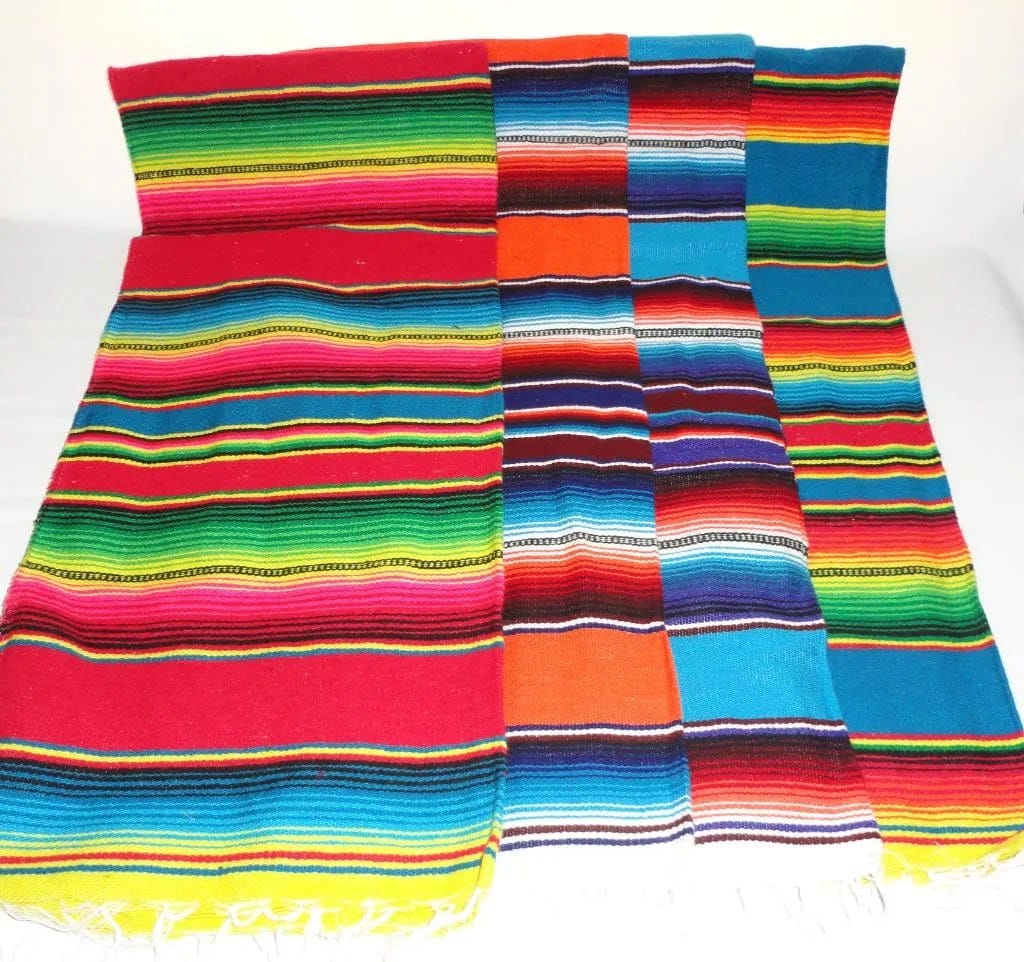More than just a blanket, the Mexican serape is a vibrant canvas of color, intricate patterns, and rich history. This guide unravels the story of this iconic textile, from its humble beginnings to its modern-day significance. Discover how to spot an authentic serape and explore whether it’s the perfect addition to your wardrobe, home, or next adventure.
Unveiling the Mexican Serape: History, Style, and Authenticity
Ever glimpsed a vibrantly patterned blanket draped artistically in a Western film or a home decor spread? Chances are, you were admiring a Mexican serape. More than just a cozy covering, the serape embodies living history, a testament to Mexican artistry and a symbol of cultural pride. Let’s delve into the captivating world of the serape, exploring its rich past, the secrets of its creation, and how to find the perfect one for you. If you’re seeking a different kind of classic experience, our Parliaments cigarettes or invigorating menthol Newports might be of interest.
A Woven Legacy: The Sarape’s Story
Centuries ago in Mexico, the sarape likely served a simple, pragmatic purpose: warmth. Imagine it as a versatile tool, a portable bedroll and shield against the chilly desert nights. Over time, it evolved into something far greater. Different regions cultivated unique styles, weaving local traditions and narratives through color and pattern. The sarape transformed from a basic necessity into a powerful expression of identity, a wearable artwork passed down through generations.
A Tapestry of Regions: Exploring Diverse Styles
Like dialects and cuisines across Mexico, the sarape boasts regional variations. The Saltillo sarape, with its vibrant, bold stripes, evokes a burst of woven sunshine. Contrast this with the intricate, almost mesmerizing designs of a sarape from Oaxaca, narrating stories through complex patterns. Each region’s signature style reflects the unique landscape, history, and artistry of its people. This diversity makes collecting serapes a captivating pursuit—each one a window into a different corner of Mexican culture.
From Tradition to Trend: The Sarape in the Modern World
Today, the sarape extends far beyond fireside warmth. It has permeated modern design. Fashion designers incorporate its vibrant colors and patterns into jackets, bags, scarves, and even shoes. Interior decorators use them to infuse homes with a pop of color and a touch of history. The sarape has transcended its traditional role, becoming a symbol of timeless style and a celebration of Mexican heritage.
Beyond the Purchase: Supporting Artisanal Traditions
Acquiring an authentic sarape goes beyond simply obtaining a beautiful item. You directly support skilled artisans who pour their heart and soul into creating these masterpieces. You contribute to preserving centuries-old weaving techniques, ensuring these traditions thrive for future generations. It’s a purchase with purpose, a connection to Mexico’s rich cultural heritage.
Caring for Your Treasure: Preserving the Sarape’s Beauty
A handcrafted sarape is an investment, a work of art deserving meticulous care. Treat it like a delicate painting or fine jewelry. Professional dry cleaning is recommended to preserve vibrant colors and intricate designs, ensuring your sarape remains a treasured possession for years to come.
The Sarape Quest: Finding Your Perfect Piece
Where can you find these treasures? Online marketplaces like Etsy and eBay offer a convenient starting point, with a wide selection of serapes to browse from home. For a truly immersive experience, consider visiting a local artisan market or, even better, traveling to Mexico. Imagine strolling through a bustling marketplace, surrounded by vibrant colors and textures, discovering the perfect sarape that resonates with you. It’s a treasure hunt worth embarking on.
A Mexican serape is more than just a blanket. It’s a story, a piece of art, and a tangible link to a vibrant culture. Whether drawn to its rich history, striking designs, or the opportunity to support skilled artisans, a sarape is a purchase you’ll cherish for years to come.
Decoding the Sarape: A Deeper Dive
We’ve touched upon the Mexican serape, but let’s delve deeper into this captivating piece of Mexican history and culture. It transcends the simple definition of a blanket or shawl; it’s a vibrant emblem of Mexican heritage, woven with stories and traditions passed down through generations.
A true Mexican serape is a work of art. Meticulously crafted using techniques honed over centuries, each thread tells a piece of the story. Skilled artisans carefully select vibrant colors and weave intricate designs, imbuing each serape with dedication and artistry.
The remarkable variety of serapes stems from Mexico’s diverse regional styles and traditions. Distinct patterns and color palettes emerge depending on the sarape’s origin, making each a unique representation of its local culture—a wearable map of Mexican artistry.
Historically, the sarape was primarily practical, providing warmth, protection from the elements, and even serving as a makeshift bedroll. Yet, it was always more than merely functional. Serapes played a vital role in cultural celebrations and ceremonies, adding a splash of color and tradition to important events. Some experts suggest certain designs and colors held symbolic meanings, connecting the wearer to their community and heritage. Today, people still wear serapes traditionally, expressing cultural pride while keeping warm. The sarape has also permeated modern fashion and home decor, appearing as stylish ponchos, eye-catching shawls, and vibrant throws. Its adaptability as both a timeless piece of cultural heritage and a trendy fashion statement speaks to its enduring appeal. Its influence extends to modern artwork and contemporary design inspiration.
The next time you encounter a Mexican serape, whether in a museum, market, or someone’s home, take a moment to appreciate the artistry and history it embodies. It’s a beautiful testament to the rich cultural tapestry that makes Mexico so unique. Perhaps you’ll be inspired to add a touch of sarape style to your own life.
Poncho vs. Sarape: Unraveling the Differences
We’ve discussed these captivating Latin American garments, but let’s clarify the key distinctions between a poncho and a sarape. While easily confused, there are crucial differences. All serapes are technically a type of poncho, but not all ponchos are serapes.
The head opening is a primary differentiator. A poncho always has one, like a cozy blanket with a head hole, offering practical warmth and protection. Serapes generally lack this opening. They are typically rectangular, often featuring intricate designs and fringes, meant to be draped over the shoulders or styled in other ways. Imagine a sudden downpour; you’d likely grab a poncho. For a special occasion celebrating heritage, a vibrantly patterned sarape might be chosen to showcase cultural pride.
Ponchos appear in various forms across Latin American cultures, but serapes are specifically linked to Mexico, deeply woven into its history and traditions. Their designs often reflect regional styles and stories, each telling its own tale.
Ponchos can be simple, prioritizing function over fashion. Serapes showcase true artistry, with bright colors, intricate weaving, and often, eye-catching fringes, often considered works of art.
| Feature | Poncho | Sarape |
|---|---|---|
| Primary Purpose | Practical Protection, Warmth | Cultural expression, Decorative |
| Head Opening | Always present | Usually absent |
| Design | Simple to complex, versatile | Intricate patterns, vibrant colors, fringes |
| Cultural Tie | Various Latin American cultures | Strongly associated with Mexico |
| Modern Use | Fashion, outdoor wear | Traditional events, cultural celebrations |
“Poncho” has become a broad term, encompassing various materials and designs, from rain capes to high-fashion statements. Serapes largely retain their traditional rectangular shape and woven patterns, preserving their historical significance. Modern interpretations exist, but the core elements remain.
Serapes hold a special place in Mexican culture, representing national pride and identity. Different regions boast distinctive sarape styles, adding another layer of meaning to these beautiful textiles.
Both ponchos and serapes exemplify Latin American textile traditions, but serve distinct purposes. The poncho offers practicality and versatility, while the sarape expresses Mexican heritage and artistry. Understanding these nuances allows appreciation of the unique story each garment tells. Research into their evolution continues, so our understanding of their distinctions may evolve.
“El Sarape”: Unraveling the Meaning
We’ve explored the vibrant Mexican serape, a textile artwork that transcends its function as a blanket. Let’s delve into the cultural significance and rich history of this captivating garment, which has captured the attention of fashion enthusiasts worldwide.
“Sarape” (or “zarape”) originally denoted a rectangular woven blanket, often fringed, serving as a versatile piece for warmth, bedding, or decoration. The term has broadened to include poncho-like garments, likely evolving gradually as people discovered new ways to use and wear these textiles.
“El sarape” translates directly to “the sarape” in English. “El” is the definite article, like “the.” While seemingly simple, this understanding unlocks insights into this iconic garment.
The serape’s history likely spans centuries within Mexico’s indigenous communities. Each region probably developed unique styles and weaving techniques, resulting in the diverse array of serapes we see today.
Traditional serapes are often handcrafted, demonstrating the artisans’ skill and dedication. Vibrant colors and intricate designs are not merely aesthetically pleasing; they often hold symbolic meaning, representing a specific region or community. This connection to heritage makes the serape more than just clothing.
The serape’s presence in modern fashion and home decor, from ponchos to wall hangings, highlights its versatility and timeless appeal, transcending cultural boundaries.
Supporting artisan communities and fair trade practices helps preserve these traditional weaving techniques for future generations, appreciating the artistry while contributing to the artisans’ well-being.
| Feature | Description |
|---|---|
| Name | Serape (or Sarape) |
| Origin | Mexico |
| Traditional Form | Rectangular woven blanket |
| Modern Variations | Poncho-like garments |
| Key Characteristics | Often fringed, vibrant colors, intricate designs |
| Cultural Significance | Symbol of Mexican heritage and national pride |
| Uses | Warmth, bedding, decoration, fashion, home decor |
While much is known about the serape, research continues. Some believe certain design motifs hold deeper meanings, and the precise origins of regional variations remain a subject of ongoing exploration, adding to the serape’s mystique.
The next time you encounter a serape, consider the artistry, history, and cultural significance woven into its fibers. It symbolizes Mexican heritage, celebrates artisan creativity, and reminds us of the power of tradition.
















